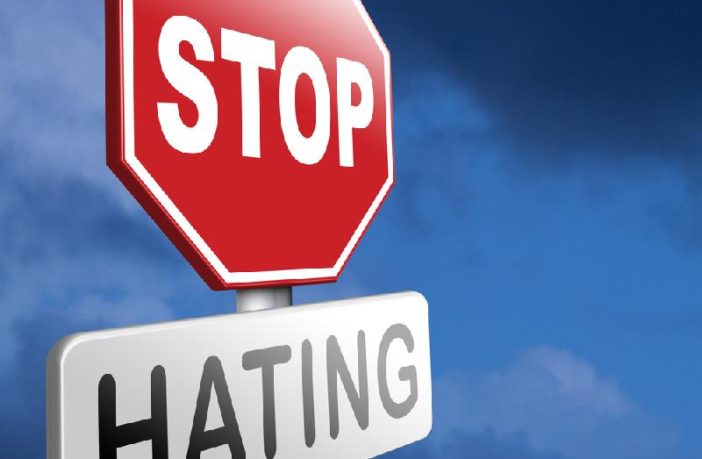*Aaron Ellis, 43, has personally experienced the pain and animosity victims of hate incidents suffer. On Jan. 30, Ellis, an editor for a press release service and a Black
resident of San Dimas, was dressed in his workout clothes and wearing a backpack filled with bricks to increase the intensity of his workout when as he started to walk around his Charter Oak neighborhood in the San Gabriel Valley, a Los Angeles County Sheriff’s Department cruiser pulled up and directed him to halt.
Within moments, Ellis reported that the officer aggressively slammed him against the cruiser hood, frisked and handcuffed him, and tossed him in the backseat of the patrol car. Someone had accused Ellis of peeking into parked vehicles. Ellis, barely 10 minutes into his 45-minute workout, said he was dumbfounded and terrified.
Racial Profiling
“The deputy said they got a call that someone matching my description was trying to break into cars,” Ellis recalled. “I said that was absurd because I just started walking. I was on the street so short of a time I didn’t have a chance to come around cars.”
The officer, Ellis remembered, acted like everything about him was suspicious. Not having his ID with him didn’t help. Two additional police cars arrived, and the deputy who detained Ellis said they would release him if they could verify that no crimes had occurred.
Stop Hating – Depositphotos
Ultimately, Ellis was released. After a tense exchange with the deputy, he walked home and told his wife what occurred.
Ellis’ dad filed a complaint at a sheriff’s station.
Hate:
The actions and presumed biases of the person who called 911 and the Latino deputy who detained Ellis were rooted in hate, Ellis believed.
“I can’t think of any other reason someone would call the police on me and say some heinous, straight-up lies unless it was race-based,” he said.
“As far as the actions of the police, they were just responding to a call.
How I was treated though — they didn’t give me a certain benefit of the doubt they would have given other people.”
UCLA’s Initiative to Study Hate aims to understand and mitigate the kind of hate Ellis experienced at the hands of law enforcement and other forms this societal issue takes. For example, how hate shows up in groups, institutions and even organizations that form to fight against it.
The three-year social impact project, launched in October 2022 with the support of a $3 million unanimous donation, brings together scholars from various specialties to explore topics such as the impact of social media hate speech on youths, racial bias in health care settings, the neurobiology underlying hate, and the unexpected areas where hate appears in daily life.
The initiative’s director, David Myers, the UCLA Sady and Ludwig Kahn Professor of Jewish History, recently said in a press release that hate is pervasive and vexing.
“But in just one year, we have gained important new insights into how it functions and how we might better address it,” he said.
During the study’s first year, researchers investigated topics including the treatment of Black youth experiencing suicidal thoughts, the roles of Black and Latinx youth in gun prevention programs, the hypersexualization of Asian women and the crimes in the U.S. motivated by race and gender, and how partisan media has spurred right-wing
extremism.
Researchers discovered that hate speech on social media affected 80% of fifth to 12th graders with 47% cyberbullied. Additionally, 75% of unhoused peoples experienced discrimination within a month, with over half stating they had been harassed or threatened.
The project will launch a podcast series within the next year and work in partnership with the California Commission on the State of Hate to develop resources and guidance for governments and communities to reduce and respond to hate activity. Another partnership with UCLA’s Alan D. Leve Center for Jewish Studies will put a spotlight on
antisemitism in the U.S. and across the globe.
The research is set to continue. A team will explore historical approaches to combat hate and how its definition can hinder its mitigation. Another group will broaden its study of hate and cyberbullying on social media to include college students. Other
researchers will analyze hate’s impact on youth and the media and information landscape, racism in childbirth, and anti-Black hate.
In an email to California Black Media (CBM), Meyers said future initiatives to study hate will examine Islamophobia and Antisemitism in response to the headline-grabbing news pouring out of the conflicts in Israel and Palestinian lands.
Initiative fellow and social scientist Kevin Gatter said the project brings scholars together to push through challenges.
“This initiative is a testament to the importance of drawing from other fields in order to produce research that will have a greater impact,” he said.
Hate crimes and incidents are on the rise in California – and they continue to impact Blacks more than any other race. According to the California Department of Justice, in 2022 hate crimes involving racism, anti-Semitism and homophobia increased by more than 20%.
Ellis said, overall, most of his experiences with people in his area are friendly. Now, he is concerned about the source of the hate he experienced.
“The ones who lurk in the shadows are who I worry about,” Ellis said.
“The person who called the police on me, I still don’t know who that is.
That is why I don’t go down that street.”
Myers said the UCLA initiative is more than a school project.
“We don’t want to simply to know how hate works,” he said. “We want
to eradicate it.”
This California Black Media report was supported in whole or in part by funding provided by the State of California, administered by the California State Library.
MORE NEWS ON EURWEB: Julianna Margulies Apologizes – Said Blacks Were ‘Brainwashed to Hate Jews’ – Susan Sarandon Also Expresses Regret | VIDEO
The post UCLA Project Explores Solutions, Responses for Addressing Hate | VIDEO appeared first on EURweb.



